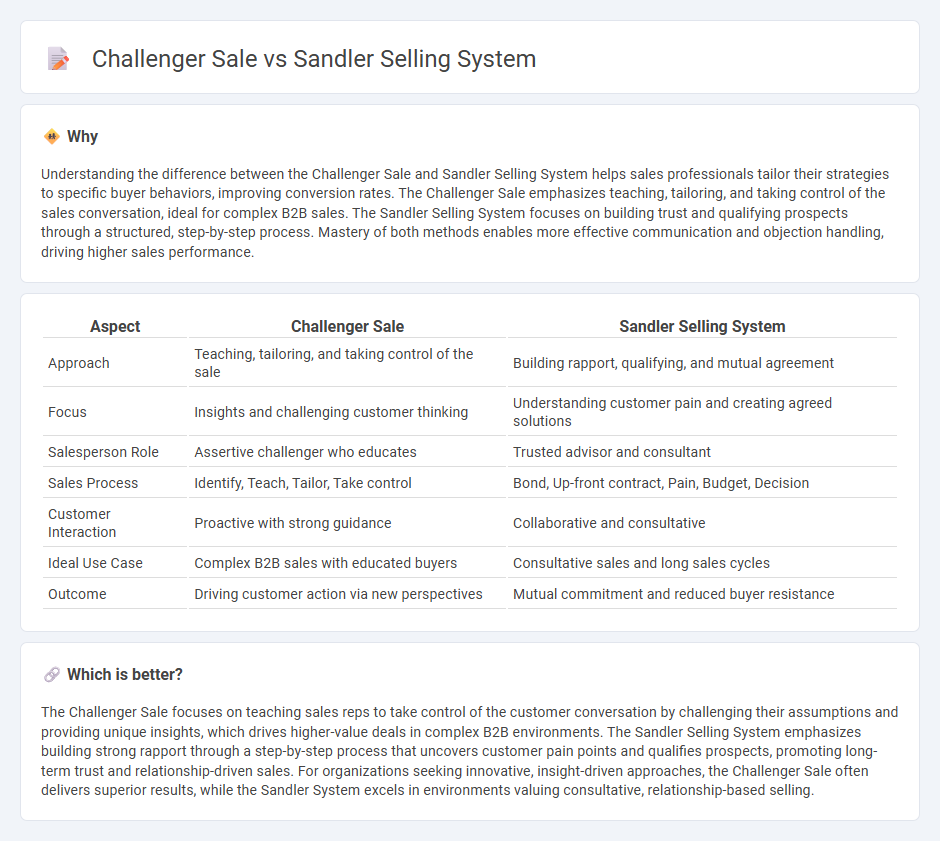
The Challenger Sale emphasizes teaching, tailoring, and taking control of the sales conversation to challenge customer thinking and deliver unique insights, driving higher-value sales outcomes. In contrast, the Sandler Selling System focuses on building strong relationships through a consultative approach, using a structured process to qualify prospects and address pain points effectively. Explore the distinctive strategies of both methodologies to elevate your sales performance.
Why it is important
Understanding the difference between the Challenger Sale and Sandler Selling System helps sales professionals tailor their strategies to specific buyer behaviors, improving conversion rates. The Challenger Sale emphasizes teaching, tailoring, and taking control of the sales conversation, ideal for complex B2B sales. The Sandler Selling System focuses on building trust and qualifying prospects through a structured, step-by-step process. Mastery of both methods enables more effective communication and objection handling, driving higher sales performance.
Comparison Table
| Aspect | Challenger Sale | Sandler Selling System |
|---|---|---|
| Approach | Teaching, tailoring, and taking control of the sale | Building rapport, qualifying, and mutual agreement |
| Focus | Insights and challenging customer thinking | Understanding customer pain and creating agreed solutions |
| Salesperson Role | Assertive challenger who educates | Trusted advisor and consultant |
| Sales Process | Identify, Teach, Tailor, Take control | Bond, Up-front contract, Pain, Budget, Decision |
| Customer Interaction | Proactive with strong guidance | Collaborative and consultative |
| Ideal Use Case | Complex B2B sales with educated buyers | Consultative sales and long sales cycles |
| Outcome | Driving customer action via new perspectives | Mutual commitment and reduced buyer resistance |
Which is better?
The Challenger Sale focuses on teaching sales reps to take control of the customer conversation by challenging their assumptions and providing unique insights, which drives higher-value deals in complex B2B environments. The Sandler Selling System emphasizes building strong rapport through a step-by-step process that uncovers customer pain points and qualifies prospects, promoting long-term trust and relationship-driven sales. For organizations seeking innovative, insight-driven approaches, the Challenger Sale often delivers superior results, while the Sandler System excels in environments valuing consultative, relationship-based selling.
Connection
The Challenger Sale and Sandler Selling System both emphasize adaptive selling techniques that focus on understanding customer needs and challenging their assumptions to create value. Both methodologies prioritize building strong relationships through tailored communication and strategic questioning, which drives better sales outcomes. Integrating Challenger Sale's insight-driven approach with Sandler's structured process can enhance a sales team's ability to engage and convert complex prospects effectively.
Key Terms
**Sandler Selling System:**
The Sandler Selling System emphasizes a consultative approach where sales professionals qualify prospects thoroughly by uncovering pain points and establishing mutual agreement early in the sales cycle. Unlike traditional methods, it relies on a continuous loop of communication and reinforcement to build trust and ensure commitment throughout the buying process. Explore how implementing Sandler's proven techniques can transform your sales outcomes and deepen customer relationships.
Up-Front Contract
The Sandler Selling System emphasizes the Up-Front Contract as a mutual agreement that sets expectations and defines roles at the start of every sales interaction, fostering transparency and trust. In contrast, The Challenger Sale prioritizes teaching and tailoring the sales conversation, integrating the Up-Front Contract subtly to control the dialogue with authority. Explore deeper insights on how each methodology leverages the Up-Front Contract to transform sales processes.
Pain
The Sandler Selling System emphasizes uncovering and addressing the buyer's pain points through strategic questioning and rapport building, fostering a collaborative sales process. The Challenger Sale focuses on teaching prospects about pain they may not fully recognize, leveraging insight to reframe their thinking and challenge the status quo. Explore the distinctive approaches of both methodologies to refine your pain-focused sales strategy.
Source and External Links
What is Sandler Selling? - Revenue.io - The Sandler Selling System is a consultative sales approach that follows a structured seven-step framework focusing on discovery, helping buyers qualify themselves by uncovering pain points and mutual fit, thereby creating a peer-to-peer interaction where the buyer does most of the talking rather than the seller pushing a product.
The Sandler Sales Method: 7 Steps for Intentional Sales Success - Indeed - The Sandler sales method consists of seven key steps including developing a bond, providing upfront communication, finding the prospect's pain points, identifying their budget, and progressing systematically to close sales while building trust and clarifying needs throughout the process.
Sandler Sales Methodology: 7 Steps to Sales Success - Salesmate - Sandler's methodology emphasizes mutual trust and respect through a seven-step sales process (Bonding and Rapport, Up-front Contracts, Pain, Budget, Decision, Fulfillment, and Post-sell), creating consultative partnerships and encouraging long-term relationship-building rather than quick wins.
 dowidth.com
dowidth.com